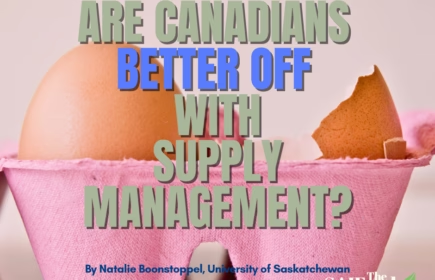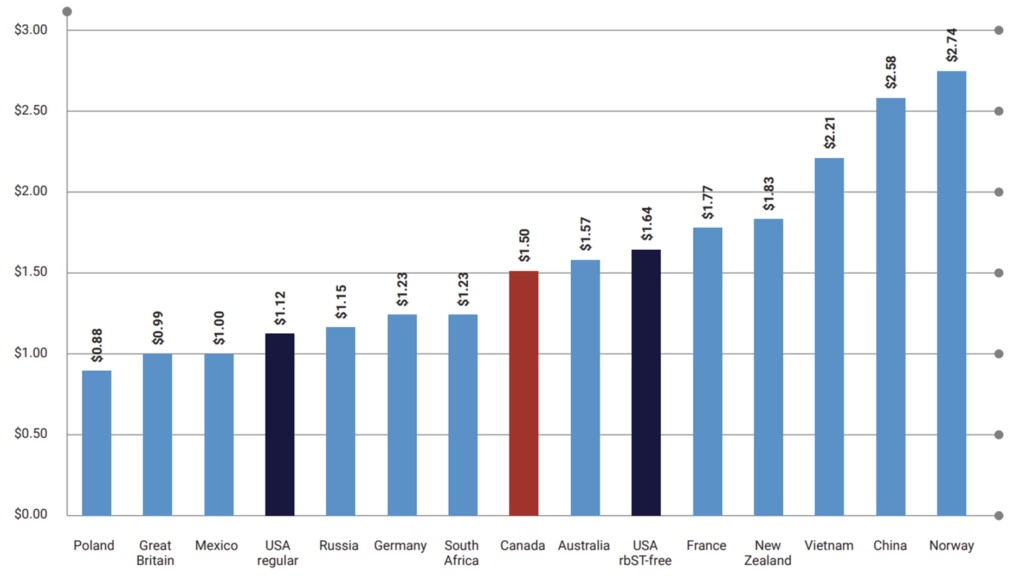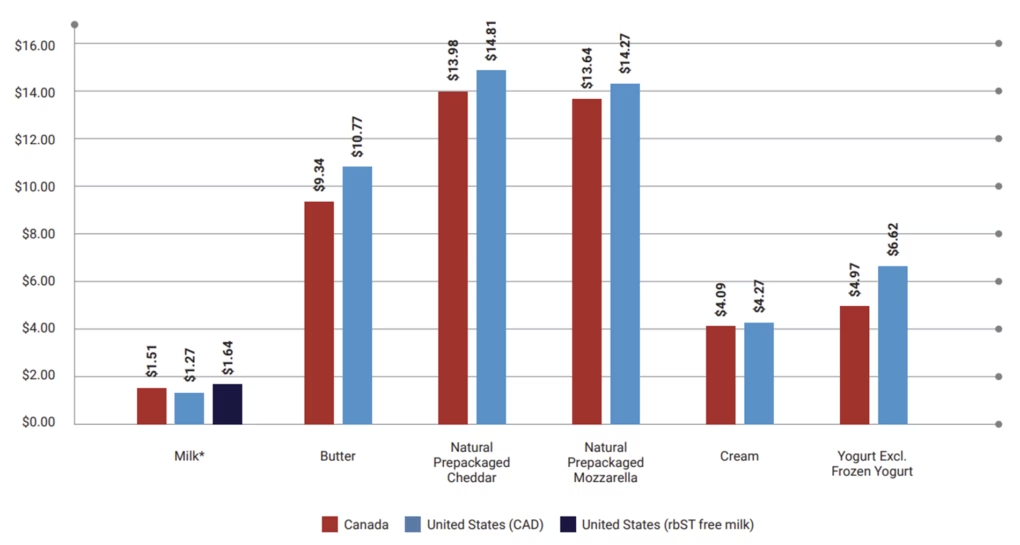Supply management was established in 1970 for the dairy, egg and poultry industries in Canada. The primary objective was to produce enough milk to meet demand and avoid overproduction. While some argue that supply management raises prices, the system has many benefits, particularly for farmers, consumers, and the broader Canadian economy. This blog will explore the key advantages and challenges of supply management and why it should stay implemented.
What is Supply Management and Why Does It Matter?
Supply management is based on three pillars: production discipline, cost-of-production pricing, and import control. It ensures Canadian dairy farmers only produce what the market needs, and that farmers receive a fair income in return. In comparison, countries without supply management, like the United States, experience fluctuations in dairy prices and have to rely on government subsidies to stabilize the industry. Recent trade agreements such as CPTPP, CETA and CUSMA have given away 8.05% of the Canadian domestic market, weakening the import control pillar by giving exporting countries access to our market. This creates more competition for domestic products and reduces the volume our farmers will be able to produce and sell. If more access is allocated, it may lead to Canada having fewer farms and less of Canadian food dollars will stay at home to support our local and regional economies.
Advantages and Challenges
Supply management offers stable prices for consumers and farmers. Farmers get a stable income and fair return for the milk they produce; consumers benefit from this price stability in retail stores. This system prevents the prices from skyrocketing, keeping fluid milk affordable and accessible as a staple good for all consumers.
A popular belief is that Canadians pay more for dairy products than other deregulated countries.
As seen in figure 1, prices are lower in the UK, Germany, Mexico, and Russia. However, fluid milk prices are lower in Canada than they are in Australia, New Zealand, and the United States, which are all deregulated countries. As well, the US has two markets of their fluid milk, ‘regular’ and ‘rbST-free’ milk. While regular milk is cheaper in the US, Canada has banned the use of rbST, therefore no milk in Canada contains this hormone. Canadians pay significantly less than Americans for butter, cheese, and yogurt as seen in the figure 2 below.
Supply management helps prevent overproduction by controlling the amount produced and balancing it with consumer demand. It prevents shortages through quotas, which require a farmer to produce a specific volume of product each month. The total supply needed is determined by the previous year’s consumption. In countries that don’t have supply management, overproduction occurs, causing milk prices to plummet which pushes farmers out of business. In Europe, they had a stabilized market like supply management, but when they removed it (to help with export opportunities), overproduction reemerged, and thousands of farmers were pushed out of business.
When milk is overproduced, it gets dumped. It happens in both regulated and unregulated countries due to a lack of processing capacity. It is rare in Canada because farmers know how much they have to produce each year, but in unregulated countries forecasting demand is in the hands of the individual farmer, where miscalculations can occur and farmers can’t find buyers for their milk.
Supply management has import controls that protect domestic farmers from foreign competition. Imports are limited in Canada so that we can be less reliant on other countries. If we were to become over-reliant on imports, we would be more vulnerable to global issues beyond our control. According to the National Farmers Union, this is done using tariff rate quotas (TRQs) that only allow a limited amount of imports into Canada at low tariff rates, but above the TRQ level, very high tariffs are applied. This is done to protect our own supply and prices.
Trade agreements have weakened this model by giving exporting countries more access to our market. In giving away part or all of our market through trade agreements, Canada will have fewer farmers and less of Canadian food dollars to support our local economy. This is because Canadian farmers can’t compete with the cost of production of American milk, so dismantling the system would lead to American milk flooding our market, putting farmers out of business and making Canadians dependent on imported milk.
Supply management reduces dependency on government subsidies. The Canadian supply management system does not require massive subsidies that unregulated countries rely on. Unregulated countries (like the US and EU) have consumers pay for their dairy at the retail level and again through their taxes to support farmers’ incomes. Canadian dairy farmers are currently getting subsidies from the Canadian government for losses from trade negotiations.
What now?
Recent trade agreements have allowed the United States to have more access to the Canadian dairy market. The CPTPP, CETA, and CUSMA trade agreements have opened up and given away 8.05% of the Canadian market, which has created more competition for domestic products. As mentioned before, Canadian farmers would get pushed out of business, and the entire Canadian dairy industry would become dependent on imported milk. To maintain the benefits of supply management, I would like to see Canada:
- Defend import controls in future trade negotiations.
- Investing in processing plants to prevent the dumping of milk.
- Adapt supply quotas to promote more innovation to reduce the cost of production in Canada.
Conclusion
Supply management has provided consumers, Canadian farmers, and governments with a stable and predictive dairy market for decades. However, with the system under pressure from trade agreements, we as consumers should understand how supply management not only affects what we pay for dairy but also the future of Canadian dairy farming. It is time for policymakers and consumers to advocate for fair trade deals and invest in infrastructure and innovation.
Charlebois, S., Bowdridge, E., Lemieux, J., Somogyi, S., & Music, J. (2021). Supply management 2.0: A policy assessment and a possible roadmap for the Canadian dairy sector. Foods, 10(5), 964. https://doi.org/10.3390/foods10050964
Dairy Farmers of Canada. (2024). Supply management: Cementing Canadian food security. Retrieved October 10, 2024, from https://dairyfarmersofcanada.ca/en/dairy-in-canada/dairy-at-work/food-security
DFC-PLC. (2024, October 1). What supply management means for Canadians. Dairy Farmers of Canada. Retrieved October 10, 2024, from https://dairyfarmersofcanada.ca/en/canadian-goodness/articles/what-supply-management-means-canadians
Export Action Global. (2018). Are Canadian consumers and farmers better off with the Canadian model? https://www.nfu.ca/wp-content/uploads/2018/05/Dairy-Systems-Around-The-World_Export-Action-Global_April-2018.pdf
National Farmers Union. (2024). Supply management. Retrieved October 11, 2024, from https://www.nfu.ca/learn/supply-management/

Natalie boonstoppel
My name is Natalie Boonstoppel, and I am currently in my third year of a Bachelor of Science in Agribusiness at the University of Saskatchewan. I was born and raised on a small dairy farm in Scotch Lake, New Brunswick, until the spring of 2015, when my family sold and bought a larger dairy farm in Grunthal, Manitoba. My passion for the dairy industry grew from working on our family farm and through my involvement in 4-H and the Western Canadian Classic. After I complete my degree, I hope to explore international agricultural practices, potentially working on a dairy farm in New Zealand or another country. My long-term goal is to continue contributing to the agriculture industry and potentially one day own a dairy farm of my own.




